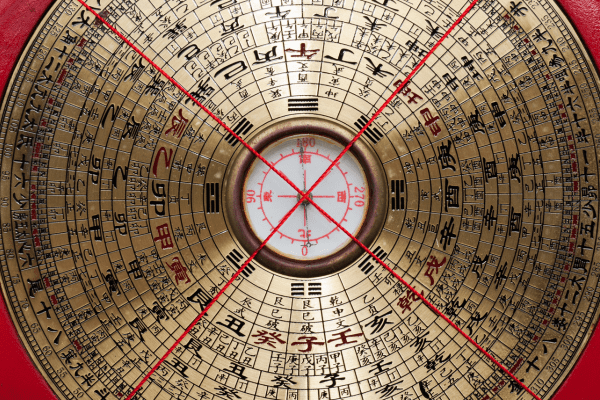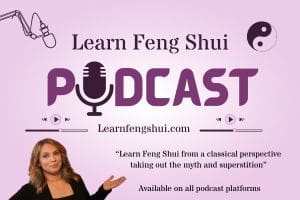How to Use Directions in Feng Shui using a Luo Pan Compass

On a recent site visit with a new client, I pulled out my luo pan and began to take directions. She said, “what is that for?!” Clients are great teachers. They challenge your assumptions, your knowledge and the application of your art. My client’s question about why I use a compass was a seemingly simple one, but the answer required an in-depth, complex and layered understanding of how the bagua, or “energy map” developed over time.
Yes, you can use the luo pan to find your “wealth corner,” however the overarching reason why a bagua is so powerful in feng shui is that is can accurately determine and depict the type of energy a given space is likely to have. If you know what type of energy you are dealing with you can then manipulate that energy in order to live a full, balanced and harmonious life.
The compass takes feng shui beyond the powerful tools of symbolism and positive intention to a technical level that allows the practitioner to manipulate energy that already exists. Energy based on how the home/lot is situated, how the layout of the home is arranged in relation to the compass direction, which in turn is impacted by surrounding landforms and man-made forms along with seasonal and astrological influences.
Sound complicated? It’s actually quite straightforward but first requires us to go back to the roots of feng shui, to nearly 5,000 years ago when Taoist Masters lived in the mountains of China. There, all things “above” (kan) and “below” (yu) were carefully studied and considered by these ancient observers- the access, flow and quality of water where they lived, the sun’s path over the land, the type of protection available through natural structures such as mountains and hills and how people and their homes were ultimately affected. For many years such observations were compiled without any formal conclusions being drawn. Observations that were then passed down for generations from Master to disciple in order to gain a greater and deeper understanding of the self, the world and beyond.
The information they gathered eventually gave them greater control over their daily lives, offering practical and useful outlines on how to choose the best lots for crops with easy access to fresh, flowing water and where to place their hearth and door based on the morning sun. These observations provided reliable, usable statistics such as hearths placed in the East were also kept warmer longer by the sun, requiring less fuel. Others were applied to the layout of homes and domestic tasks were arranged accordingly, such as having the front doors facing south in order to receive the most abundant light. This then dictated that public areas, where visitors were received and where the most active chores were done, should be placed in the front of the home, with the back part of the home, since it was quieter and dimmer with less direct sunlight, reserved for private uses and rest.
Enhanced livability through proper placement based on these ancient set of statistics is why feng shui is known as the art of placement. It is also why people relate feng shui with increased health, wealth and abundance. Living in accordance with the natural variations of sunlight, wind, water and harnessing readily available resources naturally led to better, easier, more functional work lives and less stress, which fostered deeper human connections and an increasingly well-rounded (or, following the shape of the bagua, we could say a more “well-squared”) and fulfilling existence.
The magnetic compass was then invented for ancient Chinese to more accurately determine directions for proper placement of homes and burial sites. Through the use of this at-the-time revolutionary tool, Compass School feng shui was born. The goals of Compass School are to assess and determine the quality of energy, or chi, based on compass directions along with specialized formulas that locate and predict the impact of known astrological influences over a certain period of time. Compass School took feng shui from a strictly geomantic and somewhat rudimentary art of positioning homes, burial sites and hearths to a clear and concise technical medium that can better predict the quality of energy in a given space.
There are times, however, when the compass can only tell you so much. Formulas cannot account for landforms, trees, walls, buildings, dumpsters, crazy neighbors or many other factors that influence the quality of energy. For instance, you may be shown a floor plan for a south facing home and envision that it has abundant natural light in the front of the home only to visit the lot and discover that all the sunlight coming from the south is blocked by a massive condo building directly across the street. Your South facing home is now cold and dark most of the day, until the light hits the West side of the lot. This is just one example but highlights the importance to take all factors into account and not get stuck on compass directions alone. It is but one piece of the puzzle. It is one layer in the holistic art of Compass School feng shui.
If you do not currently use a compass and are interested in applying compass directions to your practice, I would begin with first simply observing the sun. Then, buy several compasses and keep them on you. Get to know the directions in your own home and compare/observe the quality of light, how it changes throughout the day and throughout the year. Notice whether your layout is conducive to the type of natural lighting available- are your private areas more yin, are your work areas more yang? Could your layout be improved to harness more natural light?
Once you observe your own home, move on to the places you work, eat, the local park, places you travel to. Over time you will develop an internal compass, or what I call inner GPS (“Great Positioning Skill”) and be able to pretty accurately predict the type of lighting/energy you are likely to encounter in any given space. You can then put your observations to work and create feng shui floor plans and baguas based on compass directions that then accurately relate to their ruling elements. There is poetry in the directions of the bagua, a symphony of elemental creation that circles around ever so satisfactorily.
North is watery, dark and cold, asleep for the winter, where the energy moves inward to be wrapped in a blanket of quiet repose, moving on to the NE where quiet contemplation leads to inner strength and personal development, ready to bloom in the spring. Winter then thaws and melts, nourishing the eternal wood element of the East, where the sun rises daily delivering the promise of fresh starts, upward growth and the “rebirth” of spring.
This wood then becomes established, tapping into the deep resources of water beneath the ground, representing wealth and abundance attributed to the SE. This old wood eventually becoming the fuel for the fire that burns deep within- the creative life force that brings life, light, fame and accomplishments of the bright southern sky. This deep, inner fire cooling to create the Earth’s crust, grounding us, nurturing us in the SW, where love and relationships creates the cornerstone of our existence.
Going deeper, within the earth metal is created, bringing strength, precision and clarity of purpose into the west where we cannot let the sun set on humanity before creating the next generation- our children, our legacy, our ideals and creative expression. And this legacy, now nearly coming full circle in the NW, where it is protected by the patriarch, our spiritual protectors and other helpful people in our life, settling back into cooler, autumn days when it is time to once again harvest and protect our assets in order to make it through the upcoming winter.
Through studying the qualities of the feng shui directions, you will uncover the deep and meaningful beauty encapsulated in the bagua- the flow of it, the progression of time and whereby one element creates the other, one season turning into the next, each expression nourished by its neighbor which in turn empowers the next.
So you see, it’s more than just south, east, north or west. The compass directions encompass (pun intended) a feeling, an energy, an emotion, a movement, a season, a quality. Directions determine our specific place within the grander scheme of things, describe an angle of light, place the natural progression of the sun and the seasons that we experience outside, but also speak to the fluctuations of light and darkness we experience within and the season of life we happen to find ourselves in. Progression through time, your life’s legacy, the importance of creating your own path- are all determined by the direction you set yourself out on.
 Katherine Graham is a classically trained expert Feng Shui consultant trained in several schools of Feng Shui and is also a certified color consultant serving the Atlanta, Georgia area.
Katherine Graham is a classically trained expert Feng Shui consultant trained in several schools of Feng Shui and is also a certified color consultant serving the Atlanta, Georgia area.



















